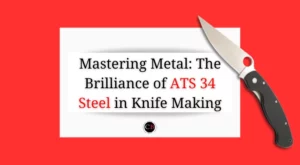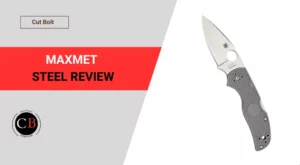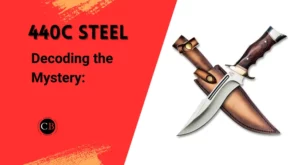If you’re interested in knife steel, especially steels for custom and small batch knives, you’ve probably heard of SAE/AISI 1080 steel. And since you’re here reading this, chances are you’d like to know more about this steel.
Well, I too was at the point where I wanted to know more about this steel, so I did some research and compiled the information I could find on 1080 steel into this post. So stay tuned and read on!
Table of Contents
What is 1080 steel?
AISI 1080 is a fully pearlitic steel (What does it mean? – Wikipedia) with a carbon content of 0.75-0.88%, which makes it a high carbon steel. Carbon steels are alloys with good to very good elastic properties and is therefore assigned to the category of spring steels.
1080 is mainly used in the automotive industry as many automotive parts such as springs and shafts have high elastic requirements due to permanent alternating loads. It is one of the most commonly used alloys.
But it is not only used in the automotive industry, it is also used in the music industry, for example in the production of piano keys.
One of the main reasons why it is so popular with manufacturers is its cost. 1080 steel is comparatively inexpensive, making manufacturing processes extremely cost-effective.
Another positive property that makes it so popular and stands out from the mass of steels is comparatively easy to work with.
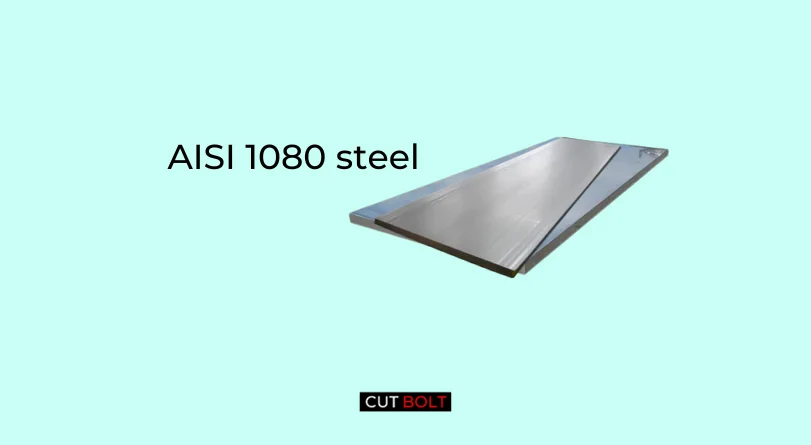
Other designations and standards of 1080 steel
AISI 1080 steel is alternatively also available under these designations:
| Standard specifications | Proprietary equivalents |
| AFNOR – XC75* | Best – BE1248 |
| AFNOR – XC80 | |
| BS – 070A72* | |
| BS – 80CS | |
| BS – 80HS | |
| BS – 060A83 | |
| DIN – D85-2 | |
| DIN – CK75* | |
| DIN – 80Mn4 | |
| EN – C75G | |
| EN – C70E* | |
| GB – #80 | |
| GOST – 75A | |
| JUS – C.1837 | |
| UNS – G10800 | |
| W-Nr – 1.1259 | |
| W-Nr – 1.1265 | |
| W-Nr – 1.1248* |
1080 Steel Chemical composition
The composition of 1080 steel may vary slightly depending on the manufacturing process. However, for it to be classified as 1080, it must be within these limits.
| Element | Portion | Effect |
| Carbon | 0.75 – 0.88% | Increasing hardness and tensile strength. In larger quantities, increase in brittleness and reduction in forgeability and weldability. |
| Manganese | 0.68 – 0.90% | Improves hardness and tensile strength. |
| Phosphorus | 0.03% | Increases tensile strength, hardness and corrosion resistance but also brittleness. |
| Sulfur | 0.05% | Increases machinability but also brittleness. |
What is the hardness (HRC) of 1080 steel?
The realistic hardness for knives made of SAE/AISI 1080 steel is 56 – 57 HRC.

Is AISI 1080 rustproof or stainless steel?
AISI 1080 spring steel is neither a rustproof nor a stainless steel. To be considered stainless, it would require a chromium content of at least 10.5 – 13% dissolved in austenite or ferrite, depending on the definition. And it is not a stainless steel either, as its sulfur and phosphorus content (so-called iron companions) of 0.05 and 0.03%, respectively, exceeds the specified limit of 0.025% (see here).
15n20 Steel for knife
Properties of 1080 Steel
According to the chemical composition and hardness of this offers:
1. Edge retention
High carbon steel such as 1080 steel is wear resistant. This means that it can maintain its sharpness much longer than comparable steels. High carbon steel maintains its sharpness even when subjected to a large force. For this reason, high carbon steel is used in many large cutting machines. If it’s good enough for these machines, it’s good enough for knives.
2. Corrosion resistance
If not properly maintained, 1080 steel will rust very easily. This means that you need to at least clean it (and better yet, oil it) after use to prevent rust. Knives made of 1080 steel should also be stored in a cool, dry place to keep rust at bay. But no matter how good the care, 1080 steel will sooner or later develop some flash rust.
3. Wear resistance
Because 1080 steel is a high carbon steel, it is exceedingly strong and well treated 1080 steel knives have the potential to last for many years. 1080 steel has high wear resistance, which means that the blade will stay sharp much longer, meaning it will need sharpening less often. The high strength of the steel also means that it is unlikely to break under high pressure. For this reason, this steel is often used for vehicle parts that are subjected to extreme pressure and/or load changes.
4. Sharpness
One of the biggest advantages of 1080 steel blades is that they are easy to sharpen. Once sharpened, 1080 steel blades retain their sharpness quite well, which in turn means they need sharpening much less frequently. Incidentally, this is also true of the vast majority of high carbon non-stainless knives. It is therefore not a unique selling point of 1080 steel knives.
5. Machinability
1080 steel is a high carbon steel with a carbon content of about 0.8%. Machinability depends very much on the carbon content. Materials with very low carbon content (below 0.15%) are too soft and rubbery, and materials with carbon content above 0.5% are harder and therefore less machinable. With its carbon content of about 0.8%, it is relatively more difficult to machine compared to average carbon steel and has a machinability rate of 48%. On the other hand, it is stronger and has better mechanical properties. Steels with high carbon content are generally less popular, alloy steels are the better choice here when better mechanical properties are required.
Toughness
According to the law of hardness and toughness, the harder the steel, the lower its toughness, but the higher its brittleness. In other words, properly heat treated AISI 1080 steel has a decent toughness that can produce large blades like swords that are tough enough to hack through branches.
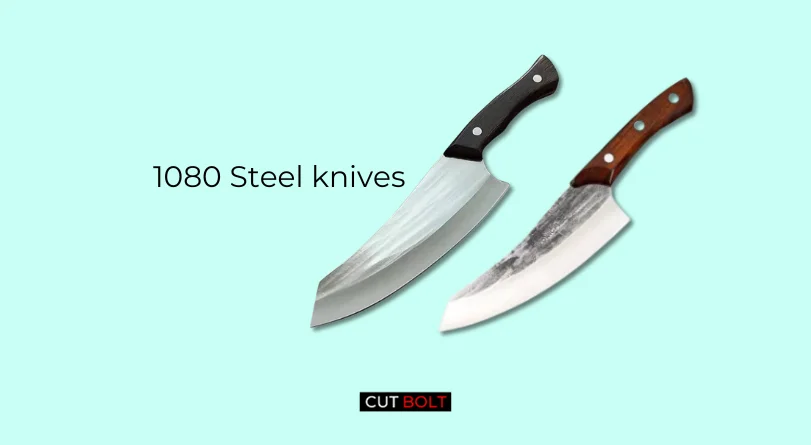
Is 1080 a good knife steel?
Definitely yes! As with everything else, there is no one best steel that is equally well suited for all applications, that should be obvious. However, 1080 steel is an excellent general purpose knife steel. From a carbon content standpoint, knives for thin filleting would generally tolerate a bit more carbon, while large cleavers would tolerate a bit less (and probably a bit more of the other alloy components). The bottom line, though, is that 1080 steel is more than fine for just about anything.
1080, along with 1084, is one of the best steels for simple heat treatment. If abraded (by grinding or milling), no normalizing is required. If forged, normalize 3x with decreasing heat.
For hardening, heat the steel to just above the non-magnetic range (1500 °F/816 °C), then soak briefly, perhaps 5 min, then quench in oil. The quenching oil should be canola oil, veterinary grade mineral oil, or a fast commercial quenching oil. Temper at 400 then 450 °F (204 / 232 °C) to achieve a hardness of 58 – 60 HRC.
1080 Steel – Equivalents
1084, as the number alone implies, is effectively the twin of 1080. There really isn’t much difference between these two steels. The 1080 steel may contain slightly less carbon, which means that it has slightly worse values in terms of abrasion resistance and edge retention. However, this is so small that it should hardly be noticeable in practice.
Comparison: 1080 vs 1095
1095 steel contains more carbon than 1080. High carbon content leads to higher hardness and lower ductility. 1095 steel is used specifically where high hardness and wear resistance requirements are needed. The 1080 steel has good elastic properties with optimum hardness and is therefore ideal for products such as cold drawn bars, springs or piano wires.
Conclusion: Is 1080 steel good for knives?
1080 steel is especially popular with custom knife makers and small batch knife makers because it is easy to work with. Many of these knife makers make great camping and outdoor knives with this material. In addition, for those on a limited budget who can’t afford or don’t want a knife in the M390 league, AISI 1080 offers a way to own a knife with high hardness. In terms of hardness only, 1080 steels are the budget-friendly version for this.
As an end user who simply wants to buy a mass production knife, however, you won’t often find this steel in knives. It is not very common to date, and almost only available in products from small cutlers.
But one thing is for sure: for those who want to take their first steps into the world of knife making/custom knives, it is an excellent steel, if not almost perfect: it is easy to handle and requires less time in the heat treatment process.

